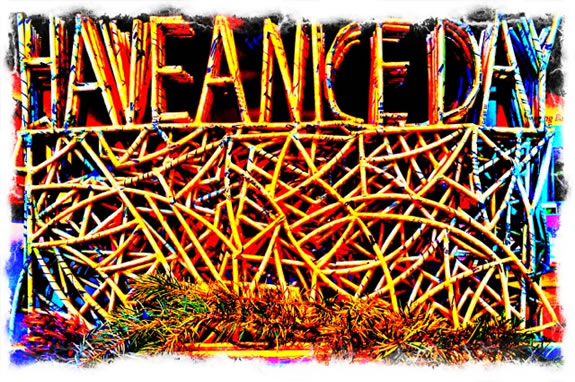
WHAT IS: “A NICE DAY?”
Nice is one of those tough words, that’s so vague and so commonly used enough that it made me ponder —
“what’s that mean?”
In my own journey, I live in a place of perpetual curiosity about words and meaning.
I listen to what people say, and how they say them, and how they stand when they say them.
And, as a student of languages, I look into the meaning of what’s being said in the most accessible phrasings of our contemporary life — and, I wonder — “what does that really mean?”
Meanings, and the under-layments of ideas, are part of the inherent work of branding.
It’s not just operational commerce —
meaning holds sway.
“If there is a brand, what’s it for?
What’s the story of it?
Who made it?
What did they stand for?
And who is it for?
What’s happening now?
Why should I care?
Or should I?
Do I?”
What’s the point?
That is the point.
When you point to a brand, you’re pointing towards the direction of it — you like where it’s going, what it stands for, its life intertwines in your own sense of appropriateness and personality.
You wear this because —
it’s you that’s wearing it.
To each their [your] own.
It “works” for you.
To that, looking in, and beneath becomes a necessary ingredient of brand audition and analysis — you have to go in, get deeper, find more — the heart and inner soul of the brand, its story and the experiences it offers.
We look for depth.
Brand spelunking.
Back to nice.
Nice is, well, nice.
Historically, nice is boring.
It was a combination that likely comes from nescius — a Latin word that means:
unknowing, ignorant, unaware and with
unwilling.
Working on a brand presentation, a client said — “that’s nice.”
And it made me think —
“what is
that word:
nice?”
Boring.
So worth thinking about the next time you consider the closing greeting:
“Have a nice day.”
Whatever.
Another word worth exploring.
Tim | GIRVIN | COASTAL STUDIOS
––––
Crowdweaving innovation >
ideation, charrettes + brand events
Girvin BrandQuest® | http://bit.ly/eiFIuP
WHAT?
Old English hwæt, referring to things in abstraction; also “why, wherefore; indeed, surely, truly,” from Proto-Germanic pronoun *hwat(cognates: Old Saxon hwat, Old Norse hvat, Danish hvad, Old Frisian hwet, Dutch wat, Old High German hwaz, German was, Gothic hva “what”), from PIE *kwod, neuter singular of *kwos “who” (see who). Corresponding to Latin quid.
EVER?
Old English æfre “ever, at any time, always;” of uncertain origin, no cognates in any other Germanic language; perhaps a contraction of a in feore, literally “ever in life” (the expression a to fore is common in Old English writings). First element is almost certainly related to Old English a “always, ever,” from Proto-Germanic *aiwo, from PIE *aiw- “vital force, life, long life, eternity” (see eon). Liberman suggests second element is comparative adjectival suffix -re.